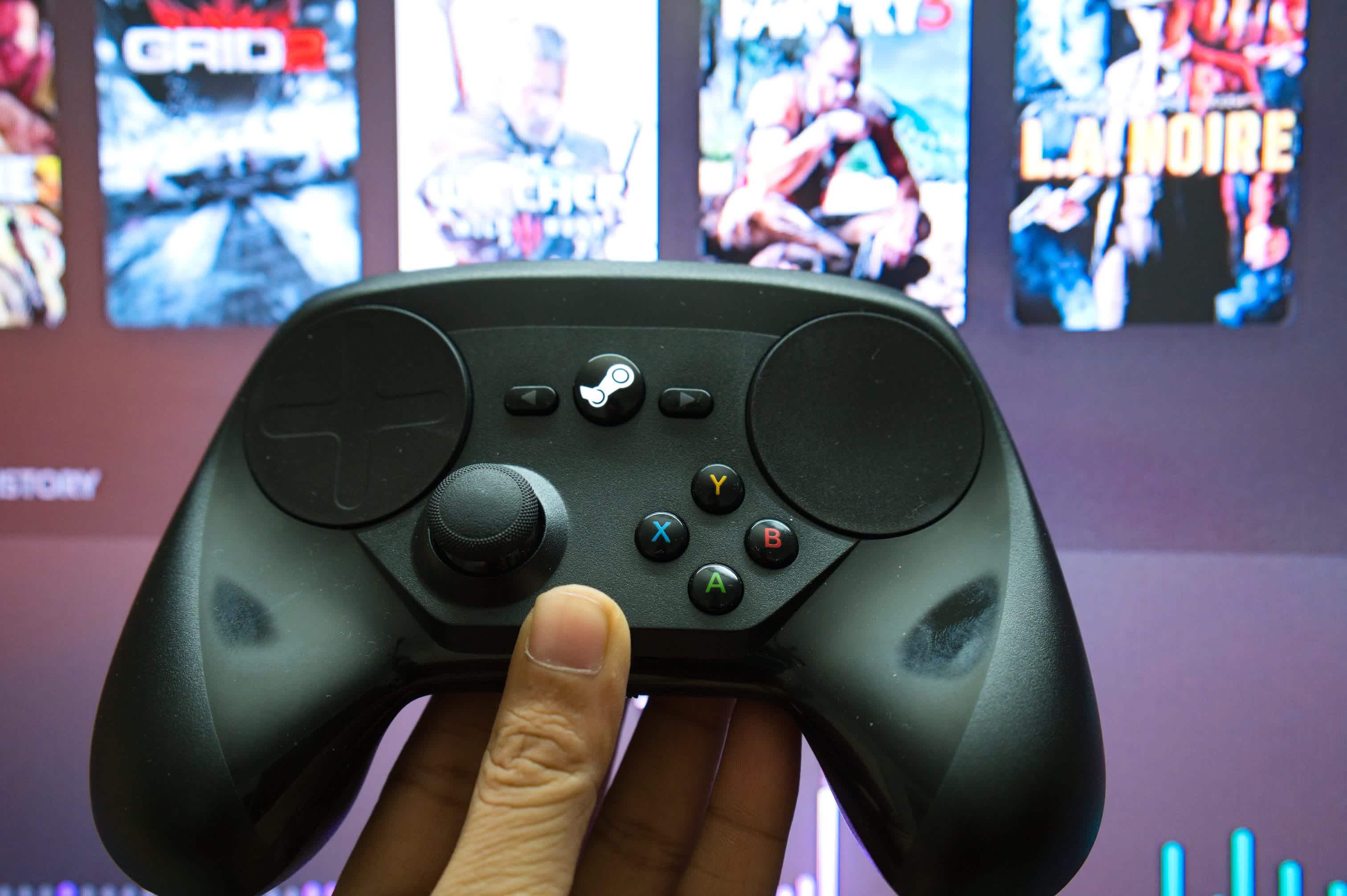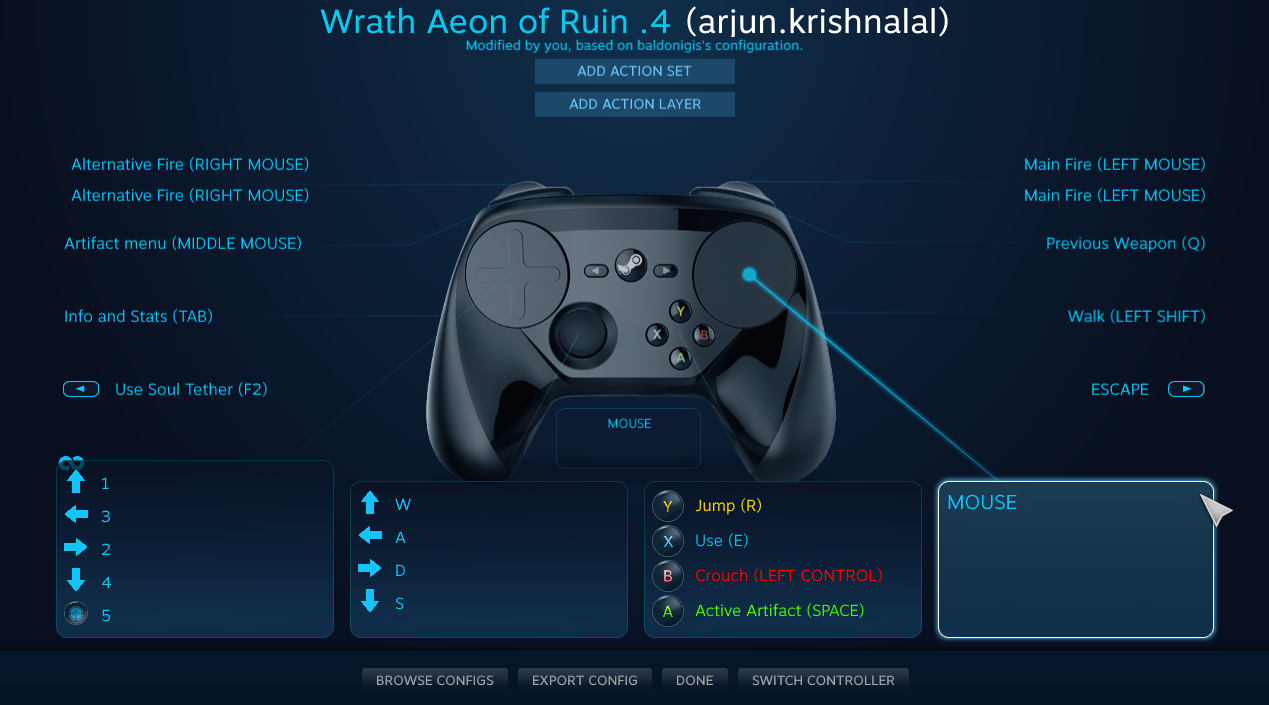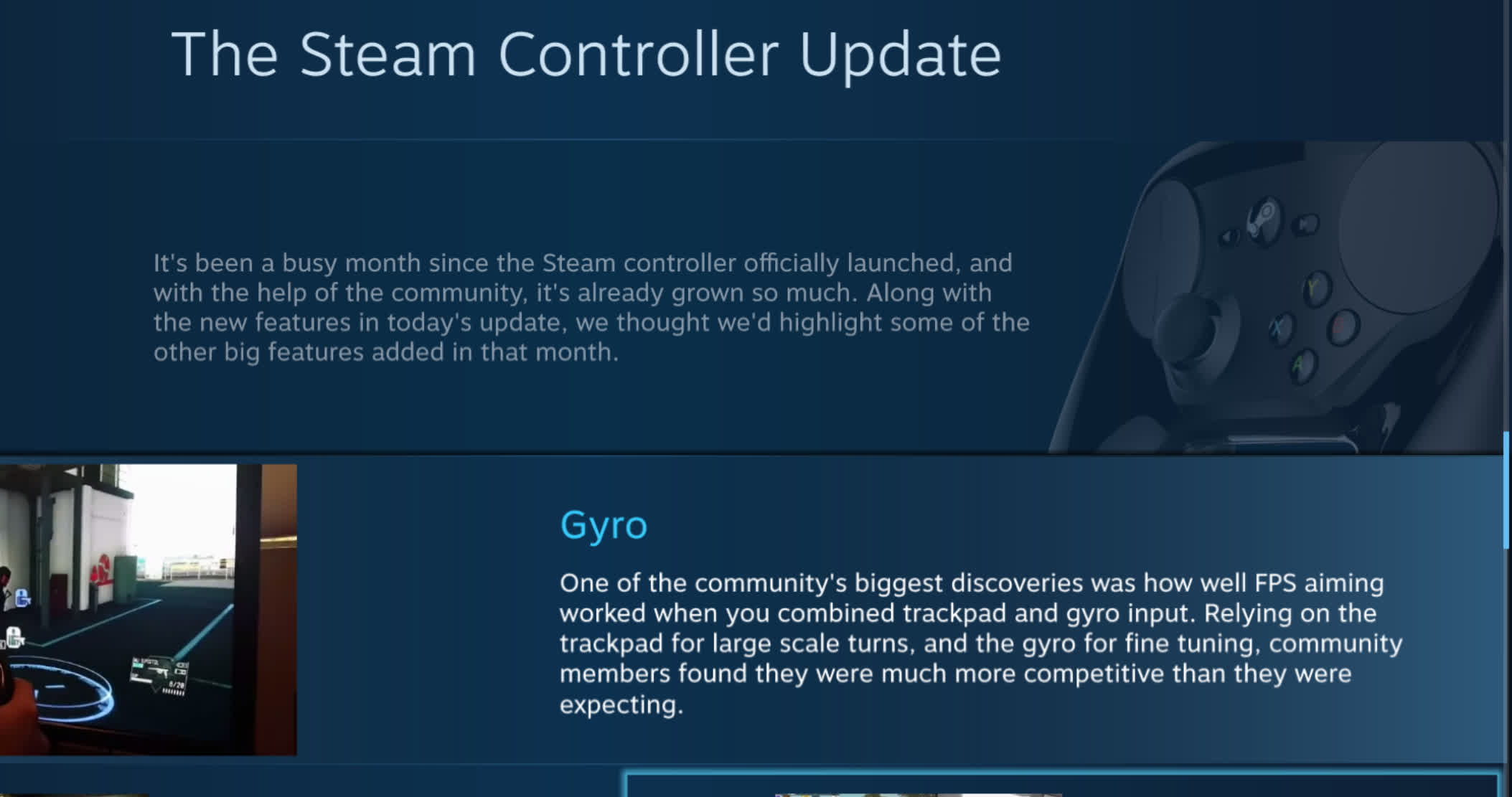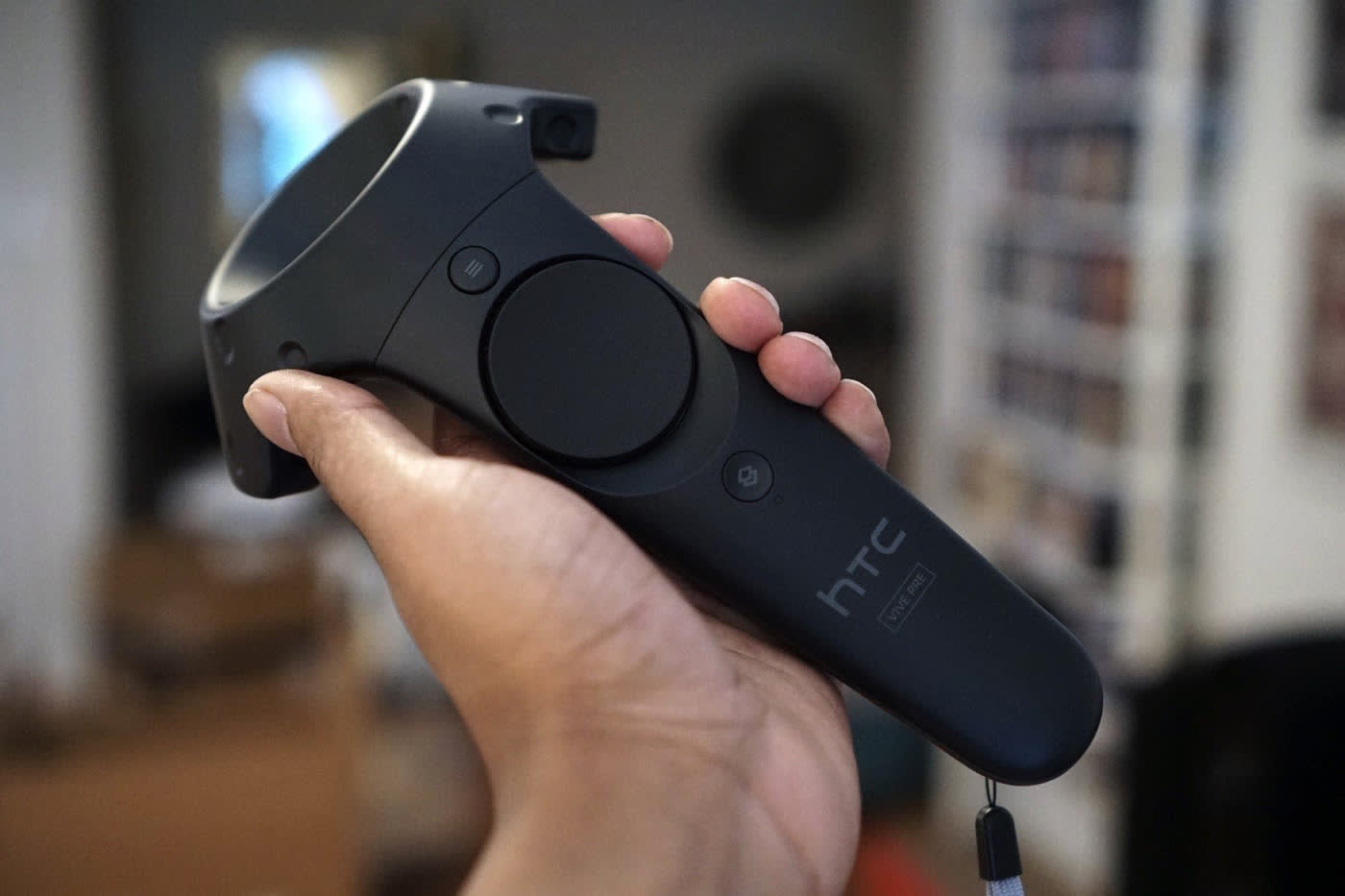I have a confession to make: I've spent several hundred dollars on Steam Controllers
No, I'1000 non crazy, and I'm not a collector of failed tech, either. Over the by five years, the Steam Controller has been my get-to device for PC gaming from the burrow. I've tried Microsoft's controller, the DualShock and DualSense, and even the Nintendo Switch Pro Controller. None come fifty-fifty shut.
Valve killed off the Steam Controller final year. Information technology was widely seen every bit a commercial failure -- which it was, with a mere 500,000 lifetime units sold. But, more than unfairly, it'south been characterized as a "bad" controller, with reviews criticizing everything from build quality to software, and the process of just getting the damn matter to work.
Some of this is justified.
But the balance is the story of how a poor launch-day experience and impatient reviewers murdered what could take been the biggest image shift in gaming input since Sony introduced dual analog sticks with the 1997 Dualshock.

A well-loved Steam Controller - Epitome: ALensAndSomeLuck
Simply, what went wrong with the Steam Controller? Is information technology as bad as initial reviews made information technology out to be? And what does the futurity concord for the new technologies it introduced?
You're using information technology incorrect! The case of the missing gyroscope
- It offers a mediocre gaming experience the bulk of the fourth dimension -- IGN
- Everytime I put it head-to-head against a standard Xbox 360 controller, Microsoft'southward stock gamepad came out ahead -- TechRadar
- This was what they came up with? There really wasn't a better manner? -- PC Gamer
When the Steam Controller launched in 2022, reviewers across the industry panned it, not just for beingness hard to use, but somehow less accurate than a standard controller with dual analog sticks.
Going through initial reviews, one primal surface area stands out on account of its omission: apart from an Engadget writeup, nearly no one who reviewed the Steam Controller at launch appeared to have any idea about how gyroscopic aiming works on it.
Gyro aiming is critical to the Steam Controller experience
Gyro aiming on the Steam Controller isn't a Sixaxis-style gimmick: it works in tandem with the right touchpad to provide mouse-similar accurateness. In most all initial Steam Controller reviews, reviewers appeared to utilize the Steam controller with gyro aiming disabled, relying simply on the trackpads.
It'southward difficult to emphasize this plenty: gyro aim is a critical office of the Steam Controller experience.
In first-person shooters, users are supposed to utilise the trackpads to moving-picture show their view in the general management of a target, then use the gyro for fine aim. By default, the gyroscope is enabled on "right pad touch." Information technology only activates when your thumb flicks the right pad. The trackpads themselves are designed for flick-aiming speed, not accuracy: flicking the correct touchpad is meant to get your scope in the general vicinity of a target, far faster than an analog stick. One time you're plus/minus a few pixels from your target, the gyro kicks in to help y'all line up that headshot.

Reviews, like this one on IGN, bemoaned how difficult it was to aim with the Steam Controller'south touchpad in games similar GTA V. The touchpad is just one one-half of the Steam Controller experience. Using it without gyro aiming enabled will cripple your accurateness.
Rather hilariously, the New York Times declared "afterwards xv hours of enquiry and testing," that the DualShock 4 was the best PC gaming controller, saying they would not recommend the Steam Controller "until Valve releases better hardware."
Imagine giving a caveman a revolver: he'll shoot himself and tell you what a terrible gild it makes. That analogy is, perhaps, the best fit for the Steam Controller'due south launch-day, gyro-free review debacle. Information technology wasn't that the Steam Controller was a shoddy piece of hardware. Valve only failed to communicate who it was for and how it actually worked.
A lack of advice
Gyroscopic aiming is a consummate prototype shift and Valve apparently didn't feel the need to educate the public or users almost it prior to the controller'due south launch. And that, virtually certainly, is their fault. Take a expect at this Steam Big Motion-picture show news update, from one month later on the Steam Controller's launch:
"Ane of the community's biggest discoveries was how well FPS aiming worked when you lot combined trackpad and gyro input."

Information technology seems that Valve itself wasn't fully enlightened about the importance of gyro aiming, at to the lowest degree at launch. Valve talked most the Steam Controller'southward gyroscope, and push button/input remapping before release. However, they never seem to have put two and two together until after release. Community members, presumably disappointed with the poor accuracy of touchpad aiming were the ones who later discovered the trackpad + gyro combination.
While YouTube videos of gyro aiming and postal service-launch review follow-ups helped with impairment control, by the end of 2022, it was already also tardily. Gamers saw the Steam Controller as a failed slice of hardware and that lack of conviction led to its eventual commercial failure.
Software and compatibility issues: besides little comeback, likewise late
When it actually works, the Steam Controller is a thing of wonder. The problem, though, is that Valve'south launch-day firmware and Steam Large Picture software simply weren't mature enough. Over the years, iterative updates and community-built solutions similar GloSc, have almost completely addressed these issues.
Just at launch, and for at least a year afterward, the Steam Controller software and compatibility experience was finicky. Doom was the first game I ran on the Steam Controller, and it was a flawless experience: simultaneous controller/keyboard input worked, equally did vibration. The big picture overlay didn't glitch out and gyro-touchpad aiming was decadently smooth at 100+ FPS.
Just about every other game had some sort of problem: the gyroscope wouldn't work in GTA Five, the Big Picture Overlay wouldn't show up in some games, others similar Fallout four didn't support simultaneous keyboard/controller input, forcing me to employ the cumbersome "mouse-joystick" fallback option.

SteamGridDBManager enables seamless Steam Controller support in Epic and Uplay games
Enough of games but refused to piece of work with the Steam Controller at all. This was in mid-2016, nearly a yr subsequently the Steam Controller came out. It'due south painful to imagine what the launch twenty-four hour period software experience would've been similar.
I'd taken a year off from gaming and only took my (worn and dusty) Steam Controller out of the cupboard one-time in late 2022. By that time, the software had matured immensely. Every bit far as bodily Steam games were concerned, compatibility issues were a affair of the past. Small quality-of-life improvements, similar enabling Steam Controller bindings without having to run Big Flick mode, made for a seamless feel. Getting non-Steam games to piece of work was still a bit of an issue: games that launched through uPlay and Origin were hit and miss, and Microsoft Shop titles wouldn't work at all.
Thankfully, a plethora of customs solutions were now available. SteamGridDBManager adds games from other storefronts to your Steam collection, without the compatibility issues that arise when using Steam's own "add a non-Steam game" role. And Alia5's GloSC (Global Steam Controller) enabled Steam Big Picture controller bindings globally, across Windows. This eliminated whatever remaining compatibility issues and made it possible to play Microsoft Store games with ease.
What's side by side?
As far as I'm concerned, the fashion forward right now is to rail down unopened, new Steam Controllers on eBay, and to stock upwardly. My first Steam Controller lasted a good five years, putting to rest the build quality problems raised in many launch-twenty-four hour period reviews. My electric current one and a backup or two should last, at least every bit long as controllers themselves are relevant input devices for gaming.
But in the bigger scheme of things, the best thing to do would be looking at the impact Valve's device has had on controller design. Even in 2022, the Steam Controller is ahead of its time. Sony, Microsoft, and Nintendo take all taken pages out of Valve'south book.
The Switch Pro and DualSense both feature HD haptics and accurate gyro aiming, the Xbox Elite controller features customizable paddles below L2/R2, the HTC Vive controller features dual trackpads. Valve themselves accept opened up control remapping -- 1 of the Steam Controller's highlights -- to all controllers that piece of work on PC.

The HTC Vive'southward controller has touchpads that are strongly reminiscent of the ones on the Steam Controller
Bits and pieces of the Steam Controller'due south legacy can exist found in every modern controller. When all of that came together in the Steam Controller, it was villainized. As Engadget put it, "we hate Valve's Steam Controller because information technology's unlike."
Less than ii million Steam Controllers have been sold over the past five years. Even in 2022 -- the device'south heyday -- Valve reported just 27,000 units in active, daily use.
Recent patents indicate that Valve might be working on a new Steam Controller with swappable components. Patents don't always turn into products, though. Waiting for a new Steam Controller could end upwards existence similar waiting for Half Life 3. Nevertheless, there's e'er hope, and the possibility that we'll see more touchpad based controllers in the years to come up.
In the meantime, my Steam Controller's got a couple more years left in it.
Masthead credit: 3dartistav
Source: https://www.techspot.com/news/88622-have-confession-make-spent-several-hundred-dollars-steam.html
Posted by: leachstratersest.blogspot.com


0 Response to "I have a confession to make: I've spent several hundred dollars on Steam Controllers"
Post a Comment